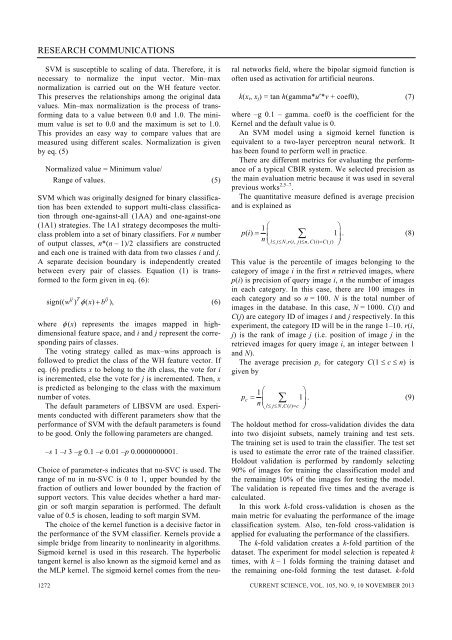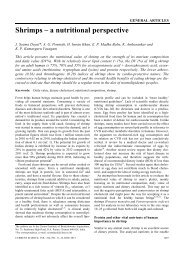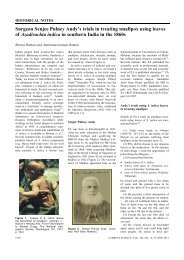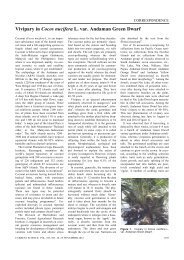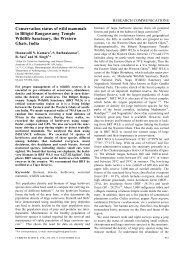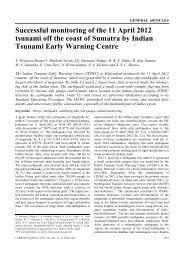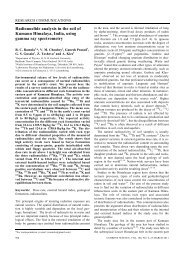Improved content-based classification and retrieval of images using ...
Improved content-based classification and retrieval of images using ...
Improved content-based classification and retrieval of images using ...
Create successful ePaper yourself
Turn your PDF publications into a flip-book with our unique Google optimized e-Paper software.
RESEARCH COMMUNICATIONS<br />
SVM is susceptible to scaling <strong>of</strong> data. Therefore, it is<br />
necessary to normalize the input vector. Min–max<br />
normalization is carried out on the WH feature vector.<br />
This preserves the relationships among the original data<br />
values. Min–max normalization is the process <strong>of</strong> transforming<br />
data to a value between 0.0 <strong>and</strong> 1.0. The minimum<br />
value is set to 0.0 <strong>and</strong> the maximum is set to 1.0.<br />
This provides an easy way to compare values that are<br />
measured <strong>using</strong> different scales. Normalization is given<br />
by eq. (5)<br />
1272<br />
Normalized value = Minimum value/<br />
Range <strong>of</strong> values. (5)<br />
SVM which was originally designed for binary <strong>classification</strong><br />
has been extended to support multi-class <strong>classification</strong><br />
through one-against-all (1AA) <strong>and</strong> one-against-one<br />
(1A1) strategies. The 1A1 strategy decomposes the multiclass<br />
problem into a set <strong>of</strong> binary classifiers. For n number<br />
<strong>of</strong> output classes, n*(n – 1)/2 classifiers are constructed<br />
<strong>and</strong> each one is trained with data from two classes i <strong>and</strong> j.<br />
A separate decision boundary is independently created<br />
between every pair <strong>of</strong> classes. Equation (1) is transformed<br />
to the form given in eq. (6):<br />
ij T<br />
ij<br />
sign(( w ) φ ( x) + b ),<br />
(6)<br />
where φ (x) represents the <strong>images</strong> mapped in highdimensional<br />
feature space, <strong>and</strong> i <strong>and</strong> j represent the corresponding<br />
pairs <strong>of</strong> classes.<br />
The voting strategy called as max–wins approach is<br />
followed to predict the class <strong>of</strong> the WH feature vector. If<br />
eq. (6) predicts x to belong to the ith class, the vote for i<br />
is incremented, else the vote for j is incremented. Then, x<br />
is predicted as belonging to the class with the maximum<br />
number <strong>of</strong> votes.<br />
The default parameters <strong>of</strong> LIBSVM are used. Experiments<br />
conducted with different parameters show that the<br />
performance <strong>of</strong> SVM with the default parameters is found<br />
to be good. Only the following parameters are changed.<br />
–s 1 –t 3 –g 0.1 –e 0.01 –p 0.0000000001.<br />
Choice <strong>of</strong> parameter-s indicates that nu-SVC is used. The<br />
range <strong>of</strong> nu in nu-SVC is 0 to 1, upper bounded by the<br />
fraction <strong>of</strong> outliers <strong>and</strong> lower bounded by the fraction <strong>of</strong><br />
support vectors. This value decides whether a hard margin<br />
or s<strong>of</strong>t margin separation is performed. The default<br />
value <strong>of</strong> 0.5 is chosen, leading to s<strong>of</strong>t margin SVM.<br />
The choice <strong>of</strong> the kernel function is a decisive factor in<br />
the performance <strong>of</strong> the SVM classifier. Kernels provide a<br />
simple bridge from linearity to nonlinearity in algorithms.<br />
Sigmoid kernel is used in this research. The hyperbolic<br />
tangent kernel is also known as the sigmoid kernel <strong>and</strong> as<br />
the MLP kernel. The sigmoid kernel comes from the neural<br />
networks field, where the bipolar sigmoid function is<br />
<strong>of</strong>ten used as activation for artificial neurons.<br />
k(x i , x j ) = tan h(gamma*u′*v + coef0), (7)<br />
where –g 0.1 – gamma. coef0 is the coefficient for the<br />
Kernel <strong>and</strong> the default value is 0.<br />
An SVM model <strong>using</strong> a sigmoid kernel function is<br />
equivalent to a two-layer perceptron neural network. It<br />
has been found to perform well in practice.<br />
There are different metrics for evaluating the performance<br />
<strong>of</strong> a typical CBIR system. We selected precision as<br />
the main evaluation metric because it was used in several<br />
previous works 2,5–7 .<br />
The quantitative measure defined is average precision<br />
<strong>and</strong> is explained as<br />
1 ⎛<br />
⎞<br />
pi () = 1 .<br />
n ⎜ ∑ (8)<br />
l ≤ j ≤ N, r( i, j) ≤ n, C( i) =<br />
⎟<br />
⎝<br />
C( j)<br />
⎠<br />
This value is the percentile <strong>of</strong> <strong>images</strong> belonging to the<br />
category <strong>of</strong> image i in the first n retrieved <strong>images</strong>, where<br />
p(i) is precision <strong>of</strong> query image i, n the number <strong>of</strong> <strong>images</strong><br />
in each category. In this case, there are 100 <strong>images</strong> in<br />
each category <strong>and</strong> so n = 100. N is the total number <strong>of</strong><br />
<strong>images</strong> in the database. In this case, N = 1000. C(i) <strong>and</strong><br />
C(j) are category ID <strong>of</strong> <strong>images</strong> i <strong>and</strong> j respectively. In this<br />
experiment, the category ID will be in the range 1–10. r(i,<br />
j) is the rank <strong>of</strong> image j (i.e. position <strong>of</strong> image j in the<br />
retrieved <strong>images</strong> for query image i, an integer between 1<br />
<strong>and</strong> N).<br />
The average precision p c for category C(1 ≤ c ≤ n) is<br />
given by<br />
p<br />
c<br />
1 ⎛ ⎞<br />
= 1 .<br />
n ⎜ ∑ (9)<br />
l ≤ j ≤ N, C( i)<br />
=<br />
⎟<br />
⎝<br />
c ⎠<br />
The holdout method for cross-validation divides the data<br />
into two disjoint subsets, namely training <strong>and</strong> test sets.<br />
The training set is used to train the classifier. The test set<br />
is used to estimate the error rate <strong>of</strong> the trained classifier.<br />
Holdout validation is performed by r<strong>and</strong>omly selecting<br />
90% <strong>of</strong> <strong>images</strong> for training the <strong>classification</strong> model <strong>and</strong><br />
the remaining 10% <strong>of</strong> the <strong>images</strong> for testing the model.<br />
The validation is repeated five times <strong>and</strong> the average is<br />
calculated.<br />
In this work k-fold cross-validation is chosen as the<br />
main metric for evaluating the performance <strong>of</strong> the image<br />
<strong>classification</strong> system. Also, ten-fold cross-validation is<br />
applied for evaluating the performance <strong>of</strong> the classifiers.<br />
The k-fold validation creates a k-fold partition <strong>of</strong> the<br />
dataset. The experiment for model selection is repeated k<br />
times, with k – 1 folds forming the training dataset <strong>and</strong><br />
the remaining one-fold forming the test dataset. k-fold<br />
CURRENT SCIENCE, VOL. 105, NO. 9, 10 NOVEMBER 2013


